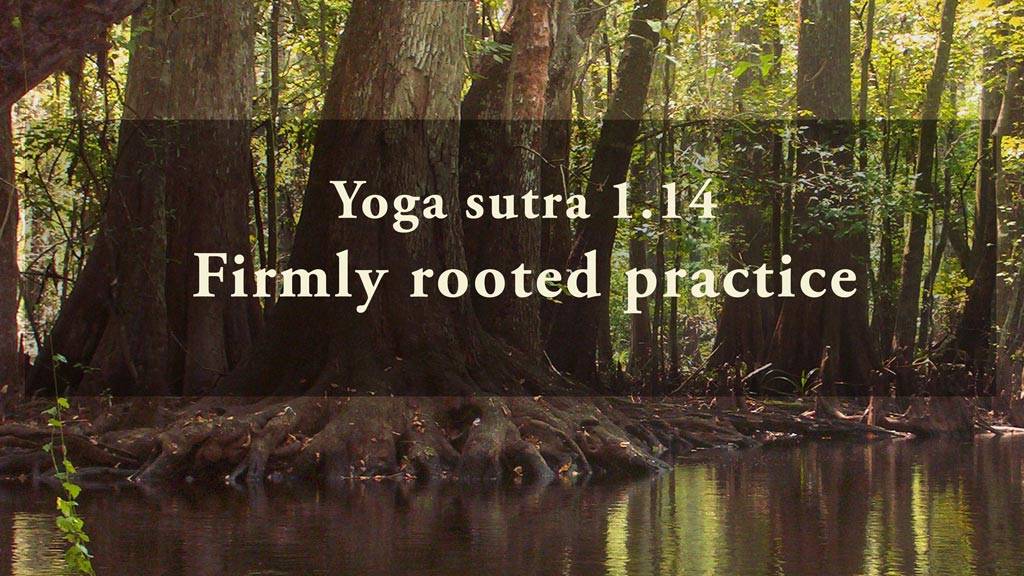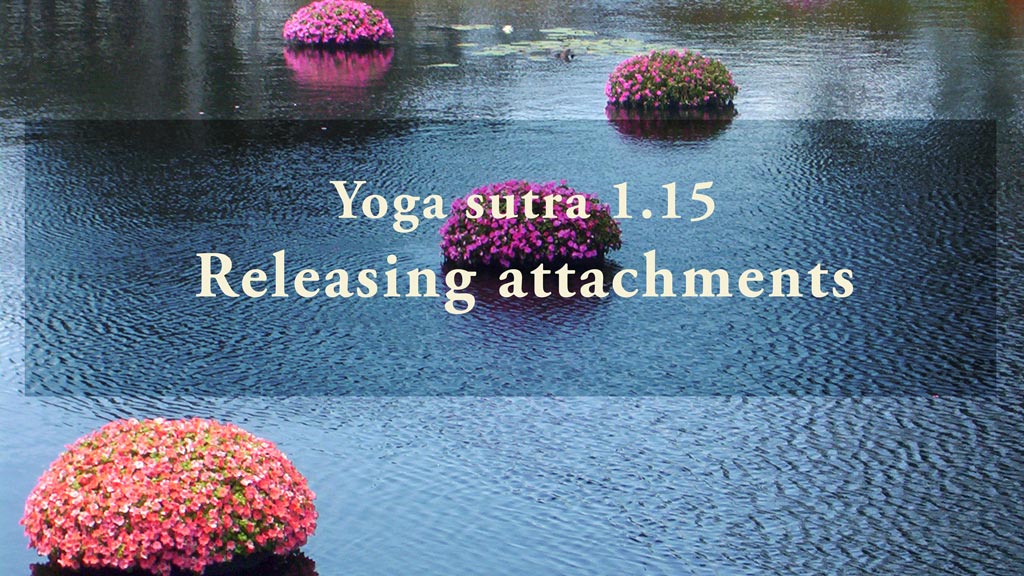
1.14 Firmly rooted practice
July 13, 2019
1.16: Awareness of Truth
July 28, 2019
1.14 Firmly rooted practice
July 13, 2019
1.16: Awareness of Truth
July 28, 20191.15: Releasing attachments


1.15 Freedom from attachment (vairagya) develops with an attitude of evenness that releases all cravings for external stimuli and internal dialogue.
When you try to give your undivided attention to the moment you are in, either in being mode or doing mode, most likely you will find your awareness pulled away from presence. In contemporary life there are endless streams of sensory stimuli competing for your attention. In fact, when you take a pause to rest and do nothing, quite possibly you will notice how you have been training yourself to shift your attention from one thing to another, and then to yet another. Your senses are constantly gathering information that your internal system decodes and interprets to decide if a response is needed. This continuous flow of information influences your thoughts, emotions and attitudes. Quite often, the main filters used to process the sensory information received are two simple questions: Do I like this? and do I dislike this? – as well as variations like Do I want this?
Sensory stimuli also evoke memories that may also bring up nostalgia, regrets and longing. Sensory stimuli can also generate anticipation, anxiety and worry. This verse is an invitation to let go of the tendency to chase after sensory stimuli as well as to release the tendency to let sensory input generate internal dialogue and reactivity. This is not about ignoring what is happening. It is choosing to feel what is happening directly and consciously, noticing without getting entangled in your internal web of opinions and stories. This verse reinforces the idea of just being with what is, as it is (being mode), to complement and counterbalance the practice (doing mode) encouraged in the previous two sutras (abhyasa) (sutra 1.13 and sutra 1.14).
To put this sutra into practice you can employ the method for presence. You choose to pause, feel, validate and clarify if what you are attending to is aligned with your intention. If it isn’t, then you can choose an option that enhances the quality of your participation in your life, right at that moment. In addition, you can make note of what distracted you. Over time you may start noticing patterns in your distractions. Examining distractions and attachments can be guided by questions such as: What are the sources of distraction for me at home, at work, in my yoga practice and in my interactions with others? What do I crave? What are the expectations, beliefs and habits I am attached to? Do I have a healthy relationship with whatever comes into my life? Am I trying to control the world outside? Do I have to have an opinion about everything? Am I entertaining myself by making up stories about everything I am experiencing? Can it be enough to just feel what is happening with clarity? You may also consider if, at a more fundamental level, the distractions you experience result from your sense of I, me, my and mine.
As you ponder these questions and observe your actions, you gradually become more aware of how you allocate your attention, which is the key to redirecting your efforts to what is truly important. You also become better able to notice if you are reacting unnecessarily to whatever enters your space of awareness. Along the way, you may feel frustrated by how distracted you are on a regular basis. This is hardly unusual. In fact, every time you notice that you got distracted, that is a sign that the practice is working because probably you did not even notice getting distracted before. So, next time you get distracted, to promote detachment, you can ask yourself: Am I taking myself too seriously? And with a gentle smile you can redirect your attention and energy to presence without strain, struggle or self-judgment. Another productive avenue for exploration is releasing expectations for the fruits of your actions: Doing for the sake of doing and welcoming whatever results. Is this possible for you?
As usual, one more way of exploring the meaning of this sutra is by chanting it.
You can choose to chant it in its traditional form with some of the words coming together:
दृष्टानुश्रविकविषयवितृष्णस्य वशीकारसंज्णा वैराग्यम् ॥१५॥
dṛṣṭānuśravikaviṣayavitṛṣṇasya vaśīkārasaṃjṇā vairāgyam
Another option is to chant each word in the sutra individually:
- dṛṣṭa
- anuśravika
- viṣaya
- vitṛṣṇasya
- vaśīkāra
- saṃjṇā
- vairāgyam
Unravel the thread is now available as a book!
If you find Simple-Yoga.org and Unravel the thread useful, consider supporting my labor with a donation, you may also donate using PayPal or Venmo. Thank you!